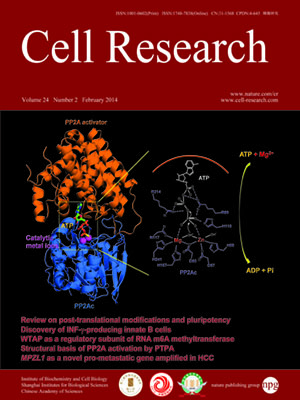
Volume 24, No 2, Feb 2014
ISSN: 1001-0602
EISSN: 1748-7838 2018
impact factor 17.848*
(Clarivate Analytics, 2019)
Volume 24 Issue 2, February 2014: 218-232
ORIGINAL ARTICLES
A novel mechanism underlies caspase-dependent conversion of the dicer ribonuclease into a deoxyribonuclease during apoptosis
Xiao Ge1,*, Xiang Zhao1,*, Akihisa Nakagawa2,*, Xinqi Gong1, Riley Robert Skeen-Gaar2, Yong Shi2, Haipeng Gong1, Xinquan Wang1 and Ding Xue1,2
1School of Life Sciences, Tsinghua University, Beijing 100084, China
2Department of Molecular, Cellular and Developmental Biology, University of Colorado, Boulder, CO 80309, USA
Correspondence: Ding Xue, Tel: +1-303-492-0271(Ding.Xue@Colorado.EDU)
During C. elegans apoptosis, the dicer ribonuclease (DCR-1) is cleaved by the cell death protease CED-3 to generate a truncated DCR-1 (tDCR-1) with one and a half ribonuclease III (RNase III) domains, converting it into a deoxyribonuclease (DNase) that initiates apoptotic chromosome fragmentation. We performed biochemical and functional analyses to understand this unexpected RNase to DNase conversion. In full-length DCR-1, tDCR-1 DNase activity is suppressed by its N-terminal DCR-1 sequence. However, not all the sequence elements in the N-terminal DCR-1 are required for this suppression. Our deletion analysis reveals that a 20-residue α-helix sequence in DCR-1 appears to define a critical break point for the sequence required for suppressing tDCR-1 DNase activity through a structure-dependent mechanism. Removal of the N-terminal DCR-1 sequence from tDCR-1 activates a DNA-binding activity that also requires the one half RNase IIIa domain, and enables tDCR-1 to process DNA. Consistently, structural modeling of DCR-1 and tDCR-1 suggests that cleavage of DCR-1 by CED-3 may cause a conformational change that allows tDCR-1 to bind and process DNA, and may remove steric hindrance that blocks DNA access to tDCR-1. Moreover, a new DNase can be engineered using different RNase III domains, including the one from bacterial RNase III. Our results indicate that very distantly related RNase III enzymes have the potential to cleave DNA when processed proteolytically or paired with an appropriate partner that facilitates binding to DNA. We suggest the possibility that this phenomenon may be extrapolated to other ribonucleases.
10.1038/cr.2013.160
FULL TEXT | PDF
Browse 2377


